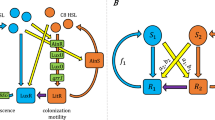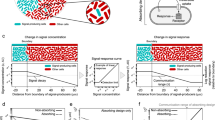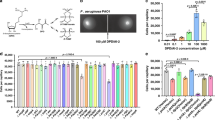Abstract
Bacteria communicate by means of chemical signal molecules called autoinducers. This process, called quorum sensing, allows bacteria to count the members in the community and to alter gene expression synchronously across the population. Quorum-sensing-controlled processes are often crucial for successful bacterial–host relationships—both symbiotic and pathogenic. Most quorum-sensing autoinducers promote intraspecies communication, but one autoinducer, called AI-2, is produced and detected by a wide variety of bacteria and is proposed to allow interspecies communication1,2. Here we show that some species of bacteria can manipulate AI-2 signalling and interfere with other species' ability to assess and respond correctly to changes in cell population density. AI-2 signalling, and the interference with it, could have important ramifications for eukaryotes in the maintenance of normal microflora and in protection from pathogenic bacteria.
This is a preview of subscription content, access via your institution
Access options
Subscribe to this journal
Receive 51 print issues and online access
$199.00 per year
only $3.90 per issue
Buy this article
- Purchase on Springer Link
- Instant access to full article PDF
Prices may be subject to local taxes which are calculated during checkout




Similar content being viewed by others
References
Bassler, B. L., Greenberg, E. P. & Stevens, A. M. Cross-species induction of luminescence in the quorum-sensing bacterium Vibrio harveyi. J. Bacteriol. 179, 4043–4045 (1997)
Chen, X. et al. Structural identification of a bacterial quorum-sensing signal containing boron. Nature 415, 545–549 (2002)
Schauder, S., Shokat, K., Surette, M. G. & Bassler, B. L. The LuxS family of bacterial autoinducers: biosynthesis of a novel quorum-sensing signal molecule. Mol. Microbiol. 41, 463–476 (2001)
Miller, S. T. et al. Salmonella typhimurium recognizes a chemically distinct form of the bacterial quorum-sensing signal AI-2. Mol. Cell 15, 677–687 (2004)
Bassler, B. L., Wright, M. & Silverman, M. R. Multiple signalling systems controlling expression of luminescence in Vibrio harveyi: sequence and function of genes encoding a second sensory pathway. Mol. Microbiol. 13, 273–286 (1994)
Miller, M. B., Skorupski, K., Lenz, D. H., Taylor, R. K. & Bassler, B. L. Parallel quorum sensing systems converge to regulate virulence in Vibrio cholerae. Cell 110, 303–314 (2002)
Taga, M. E., Semmelhack, J. L. & Bassler, B. L. The LuxS-dependent autoinducer AI-2 controls the expression of an ABC transporter that functions in AI-2 uptake in Salmonella typhimurium. Mol. Microbiol. 42, 777–793 (2001)
Xavier, K. B. & Bassler, B. L. Regulation of uptake and processing of the quorum-sensing autoinducer AI-2 in Escherichia coli. J. Bacteriol. 187, 238–248 (2005)
Henke, J. M. & Bassler, B. L. Quorum sensing regulates type III secretion in Vibrio harveyi and Vibrio parahaemolyticus. J. Bacteriol. 186, 3794–3805 (2004)
Silva, A. J. & Benitez, J. A. Transcriptional regulation of Vibrio cholerae hemagglutinin/protease by the cyclic AMP receptor protein and RpoS. J. Bacteriol. 186, 6374–6382 (2004)
Taga, M. E., Miller, S. T. & Bassler, B. L. Lsr-mediated transport and processing of AI-2 in Salmonella typhimurium. Mol. Microbiol. 50, 1411–1427 (2003)
Hacker, J. & Kaper, J. B. Pathogenicity islands and the evolution of microbes. Annu. Rev. Microbiol. 54, 641–679 (2000)
Xavier, K. B. & Bassler, B. L. LuxS quorum sensing: more than just a numbers game. Curr. Opin. Microbiol. 6, 191–197 (2003)
Surette, M. G., Miller, M. B. & Bassler, B. L. Quorum sensing in Escherichia coli, Salmonella typhimurium, and Vibrio harveyi: a new family of genes responsible for autoinducer production. Proc. Natl Acad. Sci. USA 96, 1639–1644 (1999)
Bassler, B. L., Wright, M., Showalter, R. E. & Silverman, M. R. Intercellular signalling in Vibrio harveyi: sequence and function of genes regulating expression of luminescence. Mol. Microbiol. 9, 773–786 (1993)
Daniels, D. L., Plunkett, G. III, Burland, V. & Blattner, F. R. Analysis of the Escherichia coli genome: DNA sequence of the region from 84.5 to 86.5 minutes. Science 257, 771–778 (1992)
Thelin, K. H. & Taylor, R. K. Toxin-coregulated pilus, but not mannose-sensitive hemagglutinin, is required for colonization by Vibrio cholerae O1 El Tor biotype and O139 strains. Infect. Immun. 64, 2853–2856 (1996)
Lenz, D. H. et al. The small RNA chaperone Hfq and multiple small RNAs control quorum sensing in Vibrio harveyi and Vibrio cholerae. Cell 118, 69–82 (2004)
Slauch, J. M. & Silhavy, T. J. cis-acting ompF mutations that result in OmpR-dependent constitutive expression. J. Bacteriol. 173, 4039–4048 (1991)
Acknowledgements
This research was supported by HHMI and NIH and NSF grants (B.L.B.) and a Praxis XXI postdoctoral fellowship, Portugal (K.B.X.). We thank the members of the Bassler laboratory, as well as N. Wingreen and F. Hughson for insightful discussions. We are grateful to B. Hammer for V. cholerae strains and to J. Henke for V. harveyi TTS mutants.
Author information
Authors and Affiliations
Corresponding author
Ethics declarations
Competing interests
Reprints and permissions information is available at npg.nature.com/reprintsandpermissions. The authors declare no competing financial interests.
Supplementary information
Supplementary Notes
Supplementary Figures S1 details Escherichia coli extracellular AI–2 Levels. Supplementary Figure S2 details the transcription of lsr genes in Escherichia coli. This file also contains additional references. (DOC 42 kb)
Rights and permissions
About this article
Cite this article
Xavier, K., Bassler, B. Interference with AI-2-mediated bacterial cell–cell communication. Nature 437, 750–753 (2005). https://doi.org/10.1038/nature03960
Received:
Accepted:
Issue Date:
DOI: https://doi.org/10.1038/nature03960
This article is cited by
-
It is the time for quorum sensing inhibition as alternative strategy of antimicrobial therapy
Cell Communication and Signaling (2023)
-
Effect of nisin and p-coumaric acid on autoinducer-2 activity, biofilm formation, and sprE expression of Enterococcus faecalis
Brazilian Journal of Microbiology (2023)
-
Effect of conditioned media from Aeromonas caviae on the transcriptomic changes of the porcine isolates of Pasteurella multocida
BMC Microbiology (2022)
-
Role of microalgal metabolites in controlling quorum-sensing-regulated biofilm
Archives of Microbiology (2022)
-
Sensing of autoinducer-2 by functionally distinct receptors in prokaryotes
Nature Communications (2020)
Comments
By submitting a comment you agree to abide by our Terms and Community Guidelines. If you find something abusive or that does not comply with our terms or guidelines please flag it as inappropriate.



